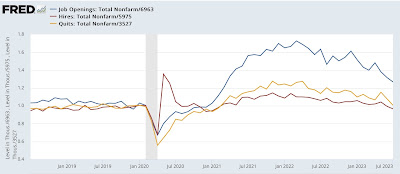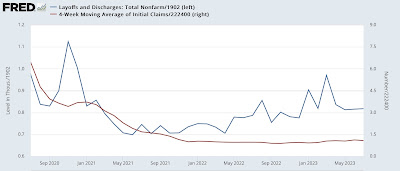July JOLTS report: is the game of reverse musical chairs in employment ending? – by New Deal democrat For the past 18 months, I’ve likened the job market to a game of reverse musical chairs, where there are more chairs put out by potential employers than there are job applicants willing to fill them. Also for many months, I have noted the gradual deceleration in that game. July’s JOLTS report not only continued that trend we’ve seen for the past 15 months of a jobs market slowly returning towards a convergence of the number of players and chairs, but in terms of actual hires and quits, the convergence has happened. Below are job openings (blue), hires (red), and quits (gold), all normed to 1 as of the average of their last 3 months before
Topics:
NewDealdemocrat considers the following as important: 2023, Hot Topics, July Jolts, New Deal Democrat, politics, US EConomics
This could be interesting, too:
Robert Skidelsky writes Lord Skidelsky to ask His Majesty’s Government what is their policy with regard to the Ukraine war following the new policy of the government of the United States of America.
NewDealdemocrat writes JOLTS revisions from Yesterday’s Report
Joel Eissenberg writes No Invading Allies Act
Ken Melvin writes A Developed Taste
July JOLTS report: is the game of reverse musical chairs in employment ending?
– by New Deal democrat
For the past 18 months, I’ve likened the job market to a game of reverse musical chairs, where there are more chairs put out by potential employers than there are job applicants willing to fill them. Also for many months, I have noted the gradual deceleration in that game. July’s JOLTS report not only continued that trend we’ve seen for the past 15 months of a jobs market slowly returning towards a convergence of the number of players and chairs, but in terms of actual hires and quits, the convergence has happened.
Below are job openings (blue), hires (red), and quits (gold), all normed to 1 as of the average of their last 3 months before the pandemic hit:

In July actual hires were -3.4% below that average. Quits were only 0.6% above that average. In other words, in terms of hires and quits, the number of each in July was almost identical to the number in the period of December 2019 through February 2020.
Only job openings remained significantly higher, to wit, 26.8% higher than their 3 month average just before the pandemic hit. But since their post pandemic high in 2021 was 72.7% higher, almost 2/3rd’s of the surge in openings has abated. And since I have always been a little skeptical of the veracity of the official openings numbers (e.g., how many are permanent, or simply fishing for applicants) the situation may have attenuated more than that.
The number of layoffs and discharges (blue below) also remains significantly tighter than before the pandemic, at -18.2% below their level for the 3 month pre-pandemic average (vs. -30.2% lower at their post-pandemic trough in June 2021). Since there is a tendency for the trend in layoffs and discharges to slightly lead new unemployment claims (red, right scale), those are shown relative to their pre-pandemic 3 month average as well:

Finally, I came across a blurb on Seeking Alpha that stated that the quits rate (blue in the graph below) was a good leading indicator for the pace of wage gains (red, right scale). I checked it out, and it did check out:

This makes sense, since I’ve described the YoY% change in wages as a long-lagging indicator, that only bottoms after the unemployment rate turns down after recessions, and indeed only when the U-6 underemployment rate declines to the 8%-9% area. And indeed it is suggesting that nonsupervisory wage gains will decelerate to about 3.8%-4% in the coming six months.
one of these statistics move in a straight line, so it would be a mistake to project this report’s relatively big moves forward. But the trend clearly remains in place. While the same is true for the unemployment rate and number of jobs gained each month in that report, I expect this same continued deceleration trend to continue in the August report this Friday.
June’s JOLTS report: slow progress towards a new equilibrium, Angry Bear, New Deal democrat
